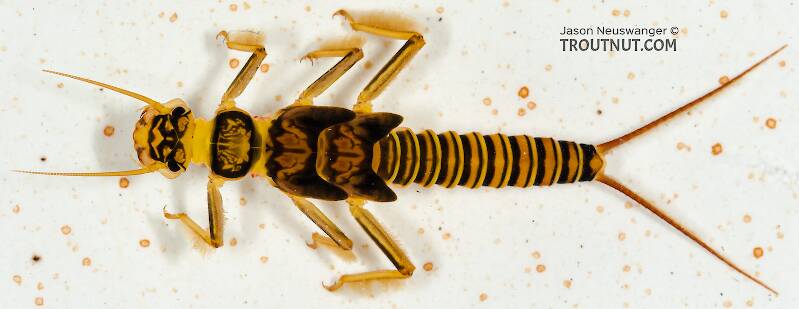
Blue-winged Olives
Baetis
Tiny Baetis mayflies are perhaps the most commonly encountered and imitated by anglers on all American trout streams due to their great abundance, widespread distribution, and trout-friendly emergence habits.
Featured on the forum

Nymphs of this species were fairly common in late-winter kick net samples from the upper Yakima River. Although I could not find a key to species of Zapada nymphs, a revision of the Nemouridae family by Baumann (1975) includes the following helpful sentence: "2 cervical gills on each side of midline, 1 arising inside and 1 outside of lateral cervical sclerites, usually single and elongate, sometimes constricted but with 3 or 4 branches arising beyond gill base in Zapada cinctipes." This specimen clearly has the branches and is within the range of that species.

Troutnut is a project started in 2003 by salmonid ecologist Jason "Troutnut" Neuswanger to help anglers and
fly tyers unabashedly embrace the entomological side of the sport. Learn more about Troutnut or
support the project for an enhanced experience here.
Medium Browns and Yellows
This common name refers to only one family. Click its scientific name to learn more.
Stonefly Family Perlodidae
These are sometimes called Medium Browns and Yellows.
This family contains some very important species inhabiting most freestone streams across the continent. They are often mistaken for early instar Perlidae (Golden Stones), which they closely resemble. The most notable differences between the two families are the perlodids much longer tails and antennae and usually more slender appearance. Their lack of obvious thoracic gilling is another difference. The most important genus of the family, Isoperla, is the easiest to recognize with its longitudinally striped abdomens (though this is not a hard fast rule).
The family can be broken down into two groups:
The subfamily Isoperlinae, or Stripetails - contains five genera; three are monotypic, one has two species, and the very large and ubiquitous Isoperla genus containing most of the species anglers call Little Yellow Stones or Yellow Sallies. These are common hatches on our freestone streams during late spring and Summer.
The subfamily Perlodinae, or Springflies - contains thirty two genera in many sizes and colors including some important medium browns, yellows, and even some olives. It also includes the large Skwala Springflies of the West. As their group name implies, these are most common in the late winter through Spring.
The family can be broken down into two groups:
The subfamily Isoperlinae, or Stripetails - contains five genera; three are monotypic, one has two species, and the very large and ubiquitous Isoperla genus containing most of the species anglers call Little Yellow Stones or Yellow Sallies. These are common hatches on our freestone streams during late spring and Summer.
The subfamily Perlodinae, or Springflies - contains thirty two genera in many sizes and colors including some important medium browns, yellows, and even some olives. It also includes the large Skwala Springflies of the West. As their group name implies, these are most common in the late winter through Spring.

I caught this female during her egg-laying flight.

This large Perlodidae stonefly was a strikingly bright yellow color, more so than any other insect I've seen. I didn't enhance it much. See the discussion threads to follow how we identified this specimen, which was listed incorrectly for several years.
See 37 more specimens...
References
- Baumann, Richard W. 1975. Revision of the Stonefly Family Nemouridae (plecoptera) : a Study Of The World Fauna At The Generic Level. Smithsonian Contributions to Zoology undef(211): 1-74.

